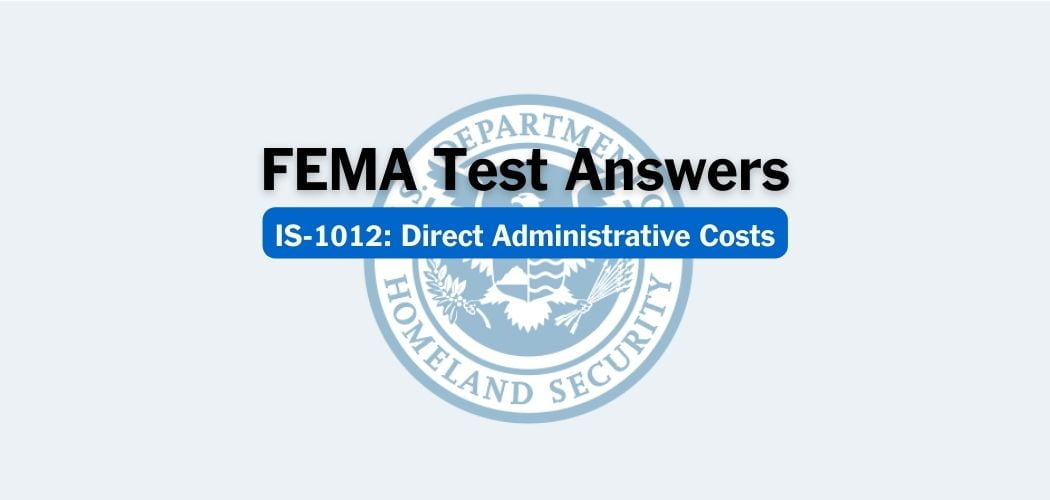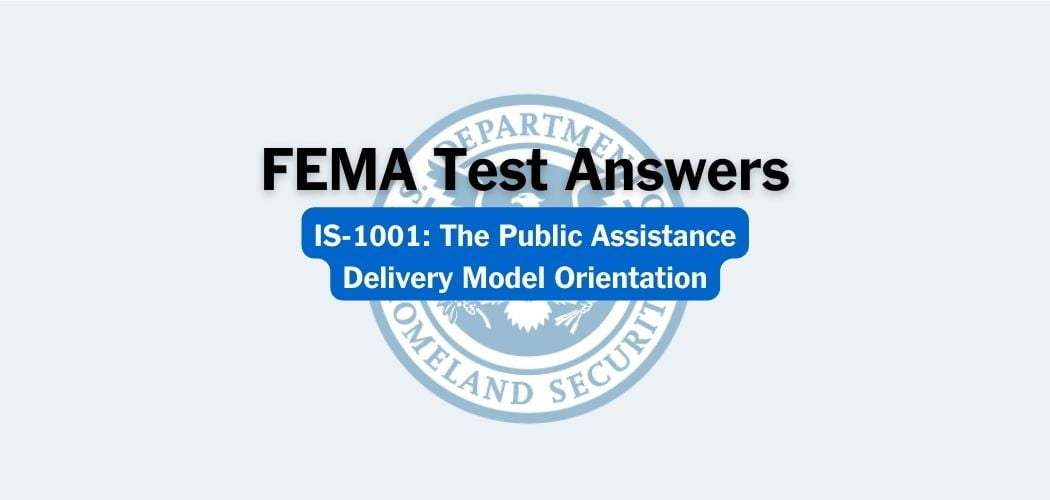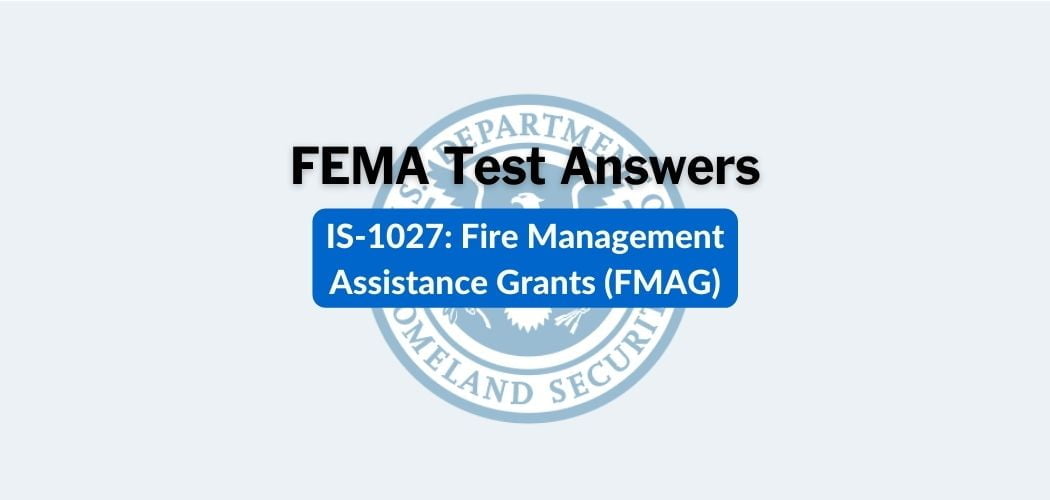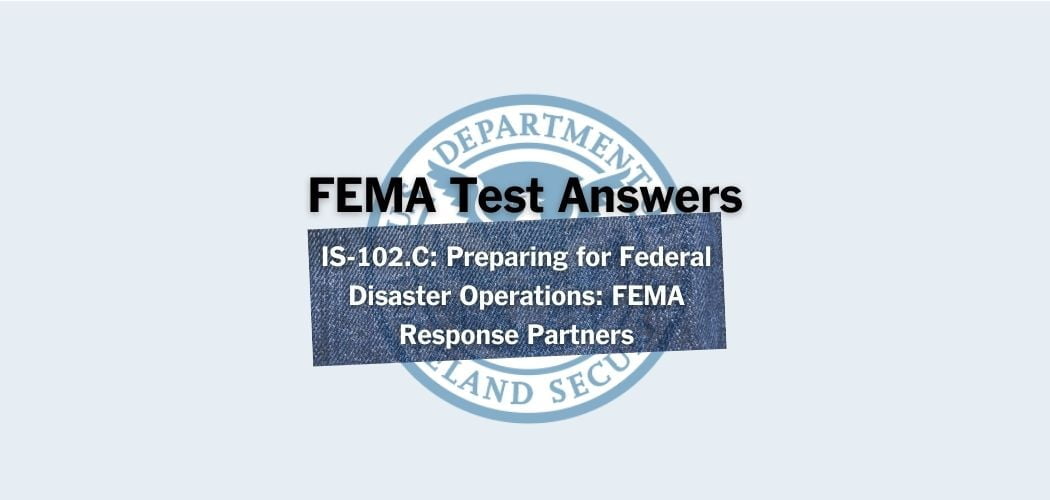Overview: The FEMA IS-363 course was published on 12/18/2018 to provide Institutions of Higher Education (IHEs) with knowledge and planning strategies to protect lives, property, and the environment by supporting operations more effectively within the context of comprehensive emergency management.
Primary audience: The IS-363 course is for individuals involved with Emergency Management at Institutes of Higher Education
FEMA IS-363 test answers
Each time this test is loaded, you will receive a unique set of questions and answers. The test questions are scrambled to protect the integrity of the exam.
Question 1. Which type of exercise is most appropriate for ensuring that campus personnel and students understand what to do in the event of an active shooter, and that law enforcement and other partners are prepared to respond?
A. drill
B. workshop
C. seminar
D. functional exercise✅
Question 2. Which of the following strategies is LEAST likely to help you engage stakeholders in the planning process?
A. Determine potential areas of conflict or confrontation
B. Answer the question, “What’s in it for them?”✅
C. Analyze what all the stakeholders have in common
D. Emphasize the need for planning expertise
Question 3. What is unique about the geographic size and/or location of institutions of higher education?
A. Colleges and universities are almost always located in the heart of a city
B. Colleges and universities often cover large geographical areas✅
C. Colleges and universities are usually limited to a very small geographical area
D. Colleges and universities are usually located next to industrial areas
Question 4. What is unique about the population of institutions of higher education?
A. It consists entirely of young adults
B. It is generally better prepared for emergencies than the general population
C. It changes from day to day, semester to semester, and year to year✅
D. It is usually limited to a very small geographical area
Question 5. Which of the following is NOT a characteristic of an Emergency Operations Center whose status condition is hot?
A. shortest start-up period required
B. utilities working
C. fully equipped
D. cheapest in day-to-day costs✅
Question 6. What is an example of a possible direct impact of a flood?
A. disruption to class and event schedules
B. displacement of students from campus housing
C. water damage to campus buildings and vehicles✅
D. respiratory illnesses from mold exposure
Question 7. Which of the following is a guidance document that describes and provides the vision for the Nation’s approach to national preparedness?
A. National Planning System
B. Annual National Preparedness Report
C. Presidential Policy Directive 8✅
D. National Preparedness System
Question 8. Which of the following is the most effective means of measuring performance, identifying opportunities for improvement, and improving interagency coordination and communications?
A. planning
B. exercises✅
C. training
D. collaboration
Question 9. Which of the following is NOT a function of the initial core planning team?
A. Provide information about resources, capabilities, threats, and risks
B. Provide information to complete a complete Plan draft✅
C. Review the full Plan after it is created and integrate additional perspectives
D. Provide information about the campus standard operations
Question 10. Which of the following statements is NOT true of Emergency Operations Centers?
A. The EOC may command the on-scene level of the incident✅
B. The EOC may be permanent or temporary
C. The EOC may be activated in advance of a potential incident
D. The EOC may be a physical location or virtual
Question 11. Which tenet of the Incident Command System allows diverse incident management and support entities to work together?
A. a clearly defined chain of command
B. the use of common terminology✅
C. modular format
D. management by objectives
Question 12. When identifying stakeholders, it is best to:
A. include a wide variety of people both internal and external to your campus✅
B. avoid involving the President or Executive so they can focus on their administrative duties
C. limit them to only those individuals who will be most directly involved in incident response
D. limit them to on-campus individuals
Question 13. A risk assessment does all of the following EXCEPT:
A. assesses vulnerability to likely hazards
B. identifies actions to perform in response to a hazard✅
C. identifies hazards that could occur
D. determines which assets will be affected by hazards
Question 14. What is the third step of the risk assessment process?
A. identify hazards
B. determine the current level of preparedness/mitigation
C. estimate severity
D. determine probability✅
Question 15. All of the following are factors to consider when setting up an Emergency Operations Center EXCEPT:
A. staff to meet requirements
B. key EOC operations for the campus
C. mitigation strategies✅
D. communication needs
Question 16. Which Mission Area includes capabilities necessary to save lives, protect property and the environment, and meet basic human needs immediately after an incident has occurred?
A. Mitigation
B. Protection
C. Prevention
D. Recovery
E. Response✅
Question 17. Which of the following is an academic recovery consideration?
A. planning for volunteer management
B. identifying methods to preserve medical records
C. planning for resumption of transportation, housing, and food services✅
D. identifying methods to evaluate degree completion
Question 18. Which statement most accurately describes the scope of the planning team?
A. to identify and implement mitigation strategies for any type of emergency or incident
B. to write an Emergency Operations Plan that addresses a specific hazard event
C. to prepare for the response and recovery from specified emergencies or incidents
D. to prevent or mitigate, prepare for, respond to, and recover from any type of emergency or incident✅
Question 19. All of the following are functions of the initial core planning team EXCEPT:
A. Clarify command structures
B. Define roles and responsibilities
C. Provide information about the campus and the community✅
D. Provide approval for the completed plan
Question 20. What is the top priority when developing incident objectives?
A. effective resource allocation
B. property preservation
C. environmental conservation
D. life safety✅
Question 21. All of the following are benefits of risk assessment EXCEPT:
A. It makes it easier to respond to and mitigate potential emergencies
B. It increases awareness of hazards, risks, and vulnerabilities among all stakeholders
C. It guides management decisions about resources for revision or creation of the emergency operations plan
D. It reduces the likelihood of hazards occurring✅
Question 22. The Emergency Operations Center for Rheagen College is having trouble meeting the needs of on-scene responders because one of their key personnel is out sick. Which factor did they fail to effectively consider in their planning?
A. communication needs
B. physical layout and setup
C. staff to meet EOC operations requirements✅
D. key EOC operations for the campus
Question 23. Which of the following is NOT an essential activation component that is needed at the start of an Emergency Operations Center?
A. primary and backup means of communications
B. recovery plan
C. map and utility diagram
D. policies, plans, procedures, and checklists✅
Question 24. Which type of exercise is most appropriate for increasing awareness among all stakeholders about the Emergency Operations Plan or a section of the plan?
A. tabletop exercise
B. drill
C. seminar✅
D. functional exercise
Question 25. What are risk assessment tools designed to do? Select the best response.
A. determine the population most likely to be affected by potential threats
B. quantify and document the probability and overall severity of various types of threat events or hazards✅
C. calculate potential losses to the university as a result of a specified hazard
D. prescribe response actions based on a given hazard scenario
Question 26. A stakeholder is a person who is ______. (Select the best description.)
A. uninterested in the actions of another
B. involved in or affected by a course of action✅
C. a first responder to an incident
D. designated by the National Preparedness System
Question 27. Which activity gathers information about potential hazards, thus making it easier to respond to and mitigate potential emergencies?
A. establishing an incident command post
B. establishing an emergency operations center
C. conducting a risk assessment✅
D. writing an emergency operations plan
Question 28. Tuttle Community College is using an on-campus chapel as a classroom after a fire damaged part of another building. This is an example of:
A. a short-term solution to a facilities issue✅
B. a long-term solution to a housing issue
C. a long-term solution to a facilities issue
D. a short-term solution to a housing issue
Question 29. All of the following are the main types of hazards EXCEPT:
A. cultural✅
B. human-caused
C. natural
D. technological
Question 30. Which of the following statements accurately describes a risk assessment?
A. identifies hazards and assesses the level of vulnerability to those hazards
B. identifies methods to facilitate recovery from a hazard
C. identifies hazards and determines actions to perform in response to those hazards✅
D. identifies a plan for stakeholder communication
Question 31. Which core capability is NOT common to all five Mission Areas?
A. Operational Coordination
B. Public Information and Warning✅
C. Planning
D. Infrastructure Systems
Question 32. Why should you analyze your planning stakeholders?
A. The institution’s President or Executive will hold you accountable for conducting this analysis and reporting on stakeholder characteristics
B. You must include a section about stakeholder characteristics in your Emergency Operations Plan
C. You need to understand factors that contribute to resistance the stakeholders may have to participate, so you can overcome that resistance✅
D. Stakeholder analysis is a required component of the Incident Command System
Question 33. The Incident Command System is required by the:
A. National Preparedness Goal
B. National Incident Management System✅
C. National Planning System
D. National Preparedness System
Question 34. When identifying stakeholders, you should:
A. not include the private sector because they do not have an interest in the institution
B. include only on-campus personnel and groups likely to be involved in emergency response
C. not include the President because he or she is too busy to be involved in emergency planning
D. consider internal and external individuals who may play a role in various aspects of campus emergency planning and response✅
Question 35. Which statement most accurately describes what risk assessment tools are designed to do?
A. determine the probability and severity of various hazard events✅
B. prescribe recovery actions based on potential hazard events
C. determine the areas most likely to be affected by potential hazards
D. calculate economic losses as a result of a specified hazard
Question 36. Which of the following is the most effective means of clarifying roles and responsibilities for emergency and disaster response?
A. plan review
B. exercises✅
C. interagency communication
D. emergency planning
Question 37. Which of the following is NOT a benefit of the Incident Command System?
A. It helps to ensure the safety of responders, students, faculty, workers, and others
B. It provides a clearly defined chain of command due to its modular format
C. It allows diverse incident management agencies to use their own distinct terminology✅
D. It helps to ensure the efficient use of resources
Question 38. Which type of exercise involves one or only a few community partners and relevant campus staff to validate a single operation or function of an agency?
A. full-scale exercise
B. functional exercise
C. drill✅
D. tabletop exercise
Question 39. What is an example of a possible indirect impact of a bombing?
A. anxiety✅
B. injuries
C. destruction of campus buildings
D. loss of life
Question 40. Which of the following is a short-term implementation strategy related to alternate housing for displaced students?
A. research code and historical preservation requirements
B. design replacement housing and secure funds and permits
C. define/find housing options and availability✅
D. analyze overall costs for constructing new residential facilities
Question 41. Whitestone University has established an Emergency Operations Center in advance of an approaching hurricane. When the storm arrives, the phone lines are damaged, and the radios the EOC has are incompatible with the ones used on the scene. Which factor did they fail to effectively consider in their planning?
A. communication needs✅
B. physical layout and setup
C. staff to meet EOC operations requirements
D. key EOC operations for the campus
Question 42. Which of the following is an example of a human-caused hazard?
A. lightning strike
B. terrorism✅
C. tsunami
D. flu outbreak
Question 43. What is unique about the operations of institutions of higher education?
A. They generally do not provide services or hold events for the general public
B. Most operate complex enterprises, such as research and development facilities, residential centers, and athletic complexes✅
C. They usually limit operations to coordination and delivery of academic programs
D. Almost all colleges and universities are closed campuses requiring student or faculty/staff identification to access
Question 44. What is the fourth step of the risk assessment process?
A. identify hazards
B. determine the current level of preparedness/mitigation
C. estimate severity✅
D. determine probability
Question 45. Which statement most accurately describes how the Emergency Operations Center (EOC) and Incident Command Post (ICP) interact?
A. The EOC directs all strategies and tactical decisions at the scene and makes requests for resources and support from the ICP
B. The ICP provides policy direction for the EOC
C. The EOC provides policy direction for the ICP
D. The ICP directs all strategies and tactical decisions at the scene and makes requests for resources and support from the EOC✅
Question 46. Which of the following is NOT an example of a risk assessment tool?
A. Risk and Vulnerability Assessment Model
B. International Association of Campus Law Enforcement Administrators (IACLEA) Potential Target Vulnerability Summary Worksheet
C. Disaster-Resistant California Community Colleges (DRCCC) Risk and Vulnerability Assessment
D. Hazard Mitigation Plan✅
Question 47. What is the first step of the risk assessment process?
A. identify hazards✅
B. determine the current level of preparedness/mitigation
C. estimate severity
D. determine probability
Question 48. Which incident management function, known as the “Doers,” conducts operations to reach the incident objectives?
A. Planning
B. Operations✅
C. Command Staff
D. Logistics
Question 49. Which of the following is a potential long-term solution related to alternate housing for displaced students?
A. use the university/college gym as a shelter
B. rebuild residential facilities with state-of-the-art protection systems✅
C. place students in a local hotel
D. change room assignments from single occupancy to double occupancy
Question 50. When is the Incident Command System used? Choose the best response.
A. throughout the lifecycle of an incident✅
B. during the response to an incident
C. at the beginning of an incident
D. during event closeout
Question 51. Which of the following is NOT a benefit of an effective Emergency Operations Center?
A. provides ready access to all available information
B. relieves the Incident Commander of the burden of decision-making ✅
C. helps establish a common operating picture
D. promotes resource identification and allocation
Question 52. Which of the following statements about Emergency Operations Plans is NOT true?
A. The EOP planning process is generally more complex than other types of planning
B. The EOP is broader in scope than other types of plans
C. The EOP is more limited in scope than other types of plans✅
D. The EOP is more comprehensive than other types of plans
Question 53. Which type of exercise involves discussing a scenario and determining how the campus will prepare for, respond to, or recover from an emergency?
A. tabletop exercise✅
B. workshop
C. seminar
D. functional exercise
Question 54. Which of the following planning considerations would most likely be the same for a city emergency manager as it would be for an institution of higher education (i.e., it is not unique to an IHE)?
A. Types of operations and activities that could be affected
B. Geographic size and location of the affected area
C. Characteristics of the affected population
D. Likely hazards from natural disasters✅
Question 55. When institutionalizing the Incident Command System, to ensure that the affected population is adequately warned in an emergency, the institution should develop a/an:
A. public information system✅
B. Emergency Operations Plan
C. resource typing list
D. recovery plan
Question 56. What is the second step of the risk assessment process?
A. identify hazards
B. determine the current level of preparedness/mitigation✅
C. estimate severity
D. determine probability
Question 57. At a minimum, how long should the planning team expect to spend to develop a good Emergency Operations Plan?
A. 6 months
B. 90 days
C. 2 to 3 weeks
D. 1 year✅
Question 58. Which statement accurately describes unit-level planning?
A. creating a plan to ensure that the organization will be able to maintain mission-critical functions or resume them quickly after an event
B. creating a plan that is specific to a building or a department, such as a plan for HAZMAT spills in the chemistry lab
C. creating a plan to ensure uninterrupted service for all major departments on a college/university campus
D. creating a plan for identifying and implementing actions to reduce or eliminate loss of life, property, and function✅
Question 59. Hazards that were caused purposefully are called:
A. cultural
B. human-caused✅
C. natural
D. technological
Question 60. Which of the following is NOT one of the three major sections of an Emergency Operations Plan?
A. Functional Annexes
B. Basic Plan
C. Agency/Department Annexes✅
D. Hazard-Specific Annexes
Question 61. The National Preparedness Goal defines:
A. What we wish to achieve✅
B. What we deliver
C. How well we are doing
D. Who we engage
Question 62. Which function of an Emergency Operations Center involves evaluating requests based on resource availability, current objectives, and policies and procedures?
A. priority setting
B. communications facilitation
C. information collection and evaluation✅
D. collaboration
Question 63. Which of the following is NOT a characteristic of an Emergency Operations Center whose status condition is cold?
A. shortest start-up period
B. utilities not working✅
C. not equipped
D. may be in a room typically used for other purposes
Question 64. What is an example of a possible direct impact of a loss of electric connections?
A. criminal activity
B. accidental trips and falls
C. loss of campus lighting and traffic signals✅
D. loss of mass notification ability
Popular FEMA test answers
- IS-005: An Introduction to Hazardous Materials
- IS-010: Animals in Disasters: Awareness and Preparedness
- IS-100: An Introduction to the Incident Command System (ICS)
- IS-120: An Introduction to Exercises
- IS-230: Fundamentals of Emergency Management
- IS-235: Emergency Planning
- IS-244: Developing and Managing Volunteers
- IS-700: An Introduction to the National Incident Management System
- IS-906: Workplace Security Awareness
- IS-907: Active Shooter: What You Can Do
- IS-909: Community Preparedness: Implementing Simple Activities for Everyone



